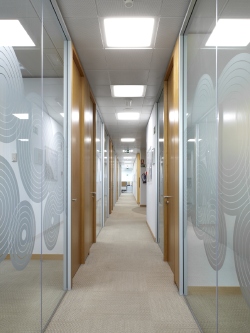Modern lighting for updating buildings

Upgrading lighting can save energy and reduce maintenance cycles, without compromising on light quality. Mike Hall of GE Lighting takes up the story.
Energy consumption is understandably a major concern for all. Many public and commercial buildings are large facilities in constant use. At the same time building owners and those managing them are under increasing pressure to reduce energy and save money — all the while faced with difficult budget restraints.
Thankfully, as designers, engineers and owners search for ways to minimise the operating costs and environmental impacts of buildings, while also increasing their functionality and appeal to occupants, the advantages of modern lighting have been given the recognition they rightly deserve.
In most cases, lighting can have the single most significant impact on the reduction of energy use and maintenance cycles for a building. Although many may still look toward achieving higher lumens per watt, incorporating lamps that deliver longer life will have a positive effect on total cost of ownership.
This extended life will afford benefits in two ways. One is the reduction in replacement costs as modern lamps can last five, 10 or even 20 times longer than traditional technologies. This eliminates the need to replace the lamps for many years and also reduces the need to carry stocks of replacement lamps.
A reduction in replacement lamps also results in savings in labour costs, particularly in areas where lighting is difficult to access — perhaps in a building with a high atrium requiring equipment to carry out the task or where maintenance has to be managed outside of normal office hours. So, although upgrading to new technologies may require a higher initial investment, payback is rapid, and overall lifetime costs are significantly lower.
As requirements have changed over the years, manufacturers have concentrated on delivering what was necessary. Today that is all about making upgrading to the latest lighting technology as straightforward as possible and in a way that will not be detrimental to the aesthetics of the building.
It comes as no real surprise to anyone dealing with lighting specifications that the LED is the number-one option on everyone’s list, having positioned itself as one of the front-runners in energy-efficient lighting technology. A wide range of retrofit lamps are available that offer the aesthetic qualities of conventional lamps, significant energy savings and a longer life to minimise maintenance costs.
 |
| LEDs are not always the best energy-efficiency solution. Watt-Miser lamps can directly replace standard linear fluorescent lamps and cut energy costs by up to 10%. |
Anyone still under the impression that LEDs are not yet ready for the commercial environment might find themselves pleasantly surprised. GE Lighting’s Lumination LED luminaires are an ideal replacement for traditional T5 and T8 lamps and can offer up to 40% energy savings. In addition, their controlled light distribution also means that in a large majority of cases fewer fittings are needed to achieve a similar or improved aesthetic.
Designers for public and commercial buildings also need to be thinking about safeguarding a lighting investment. If a new lighting scheme is installed, it makes financial sense to opt for a module-based system that allows for the simple replacement of the LED lamp without the need to replace the whole fixture. This is a key issue to consider as it means the end user won’t be stuck with a range of lamps in situ five or 10 years down the line and unable to upgrade cost effectively.
And although there won’t be huge number of manufacturers saying it, it is vital to remember that LEDs are not the only answer when it comes to saving energy and reducing maintenance cycles. In fact, often in a retrofit scenario, the required level of investment for LED doesn’t always make it a feasible option. Even in a redesign situation, LEDs are sometimes simply not the preferred choice.
Linear fluorescents can also help to make energy savings. For example, the GE Watt-Miser range is specifically designed to reduce energy in existing installations. For large offices or public buildings where lighting is on for long periods of time, these lamps can cut energy costs by up to 10% versus standard linear fluorescent lamps. In addition, Watt-Miser lamps have been developed to be direct replacements, meaning no new ballast or fitting is required; they are available in T5 and T8 versions.
 |
| The greater efficiency and longer life of modern light sources combine to deliver attractive savings. |
Another viable option is the latest CFL downlights as, again, simply opting for products that offer longer life can make significant savings. With some CFLs achieving 20 000 h of life, switching the specification will extend maintenance cycles, bringing an organisation real cost savings on re-lamping.
Whatever the eventual lighting choice — LED, linear fluorescent or CFL — those responsible for lighting within public and commercial buildings have many different factors to take into account. Reducing energy and maintenance will feature high among them — but, understandably, no-one wants to let lighting levels suffer.
The good news is that today there is a multitude of options available to ensure the lighting is not only fit for purpose but performs as expected for many years to come.
Mike Hall is sales general manager for the UK and Ireland with GE Lighting.







